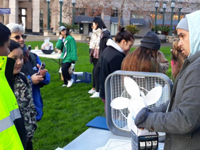How California Became Ground Zero for Climate Disasters

How California Became Ground Zero for Climate Disasters Outlet Full Name: New York Times News Date: September 20, 2020 The same manufactured landscapes that have enabled California’s tremendous growth, building the state into a $3 trillion economy that is home to one in 10 Americans, have also left it more exposed to climate shocks, experts […]
Why Aren’t We Heeding Mother Nature’s Warnings?

Why Aren’t We Heeding Mother Nature’s Warnings? Outlet Full Name: Bloomberg News Date: September 19, 2020 Wildfires from California to the Arctic permafrost are failing to convince enough people of the urgency for action on climate change.
Sørensen, Thomas
Thomas Sørensen Business Development Technical University of Denmark Thomas is a business developer for the Technical University of Denmark. He has worked at the University’s PowerLabDK since 2016. Thomas is responsible for the daily operations of the PowerLabDK, business development, and application writing. He has been involved in numerous projects related to EV infrastructure, EV […]
Agustin, Arnold
Arnold Agustin Energy Program Manager Naval Facilities Engineering Command, Mid-Atlantic Mr. Arnold Agustin is the Energy Program Manager at Naval Facilities Engineering Command, Mid-Atlantic (NAVFAC Mid-Atlantic). In this capacity, he is responsible for leadership and overall program management of NAVFAC Mid-Atlantic’s Energy Program in the Public Works Business Line. The Energy Program provides policy guidance, […]
Vitti, Raphael
Raphael Vitti Senior Energy and Data Engineer Berkeley Lab Raphael Vitti, PE is a Senior Energy and Data Engineer at Berkeley Lab. He is part of the Sustainable Berkeley Lab team working to minimize the Lab’s greenhouse gas emissions and environmental impact. He leads and supports activities to improve energy, water and operational performance in […]
Weyandt, Chris
Chris Weyandt Control Systems Engineer Berkeley Lab Chris Weyandt leads the ongoing commissioning program for Sustainable Berkeley Lab, aimed at improving the energy performance of LBNL facilities. He draws on his background in facility maintenance, construction, electronics engineering, information technology, and building automation systems to develop innovative solutions for the modernization and optimization of buildings. […]
Carter, Deidre
Deidre Carter Energy and Sustainability Manager Berkeley Lab Working to reduce Berkeley’s Lab electricity, natural gas, and water consumption through building energy management and efficiency to meet DOE and University of California sustainability and energy efficiency goals. Working to minimize Berkeley Lab’s greenhouse gas emissions by reducing energy through ongoing commissioning (OCx) and procuring longterm […]
Chamberlain, Bruce
Bruce Chamberlain Campus Energy Manager University of California, Berkeley Bruce Chamberlain’s career has focused on energy efficiency and leadership in public, private, and non-profit sectors. He is committed to bending the curve of carbon emissions in proven and creative ways. Over the past 30 years, Bruce has gained experience in managing, supervising and coordinating activities and […]
The Air Quality’s Terrible Out There. So How Can You Keep It Clean Indoors?

The Air Quality’s Terrible Out There. So How Can You Keep It Clean Indoors? Outlet Full Name: KQED News Date: September 11, 2020 we create, says Theresa Pistochini, engineering manager at the UC Davis Energy Efficiency Institute and Western Cooling Efficiency……
Helping Kids Protect Themselves From Dirty Air, One DIY Filter at a Time

Helping Kids Protect Themselves From Dirty Air, One DIY Filter at a Time Outlet Full Name: KQED News Date: August 26, 2020 What can we teach young people about how to prepare for both our current reality, which is forest fires, as well as the escalating level of climate-related disasters that are guaranteed to come?

